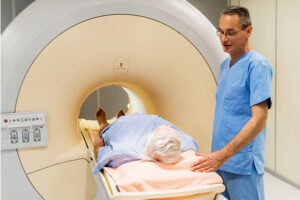Oncology
Prostate Cancer
Screening and Treatment for Osteoporosis in Advanced Prostate Cancer
Overview
Skeletal-related events (SREs) can be a significant cause of morbidity in men with advanced prostate cancer, particularly those with metastatic disease. With prompt identification of increased osteoporotic fracture risk, patients should initiate preventive interventions before fractures develop.
Expert Commentary
Leonard Gomella, MD
|
|
“We cannot ignore bone health in patients with advanced prostate cancer. Providers caring for these at-risk men must emphasize the importance of engaging in basic preventive interventions to maintain bone health, such as performing weight-bearing exercises, refraining from smoking, limiting alcohol use, and taking calcium and vitamin D supplements.”
As men age, they begin to have a natural decline in testosterone levels and muscle mass, which puts them at risk for developing osteoporosis. To help preserve bone health, I tell my patients with and without prostate cancer to limit alcohol use, avoid smoking, do weight-bearing exercises, and get an adequate amount of vitamin D and calcium. However, for men who have advanced prostate cancer, the risk for osteoporosis is amplified due to androgen deprivation and low testosterone levels. Another consideration in this patient population is the increased risk for fractures in those with bone metastases. Therefore, we must utilize available tools to help identify patients who may be at risk for osteoporosis and potential complications. For example, the fracture risk assessment tool FRAX evaluates a patient’s risk of developing a fracture, and DEXA (dual‐energy x‐ray absorptiometry) scans are used to quantify bone mineral density.
Men with advanced prostate cancer are at an increased risk for SREs due to both bone metastases and treatment-induced bone loss. These can include hip fractures, spinal cord compressions, volume loss, and vertebral body collapse. Hip fractures, which are the most common SREs in patients with advanced osteoporosis, contribute to a higher mortality rate in men than women. Bisphosphonates (ie, zoledronic acid and alendronate) and denosumab are administered twice per year to maintain bone mineral density and bone health in men receiving androgen deprivation therapy. In the presence of bone metastasis, they are administered more frequently.
While we would like to regularly screen all of our patients for osteoporosis, that may not be a possibility due to cost; however, we cannot ignore bone health in patients with advanced prostate cancer. Providers caring for these at-risk men must emphasize the importance of engaging in basic preventive interventions to maintain bone health, such as performing weight-bearing exercises, refraining from smoking, limiting alcohol use, and taking calcium and vitamin D supplements. Basic supplementation should include 500 mg of calcium and 400 IU of vitamin D daily.
References
Doria C, Leali PT, Solla F, Maestretti G, Balsano M, Scarpa RM. Denosumab is really effective in the treatment of osteoporosis secondary to hypogonadism in prostate carcinoma patients? A prospective randomized multicenter international study. Clin Cases Miner Bone Metab. 2016;13(3):195-199. doi:10.11138/ccmbm/2016.13.3.195
El Badri SAM, Salawu A, Brown JE. Bone health in men with prostate cancer: review article. Curr Osteoporos Rep. 2019;17(6):527-537. doi:10.1007/s11914-019-00536-8
Joseph JS, Lam V, Patel MI. Preventing osteoporosis in men taking androgen deprivation therapy for prostate cancer: a systematic review and meta-analysis. Eur Urol Oncol. 2019;2(5):551-561. doi:10.1016/j.euo.2018.11.001
McKay RR, Taplin ME, Choueiri TK. Optimizing bone health and minimizing skeletal morbidity in men with prostate cancer. Hematol Oncol Clin North Am. 2013;27(6):1261-1283, ix. doi:10.1016/j.hoc.2013.08.009
Poon Y, Pechlivanoglou P, Alibhai SMH, et al. Systematic review and network meta-analysis on the relative efficacy of osteoporotic medications: men with prostate cancer on continuous androgen-deprivation therapy to reduce risk of fragility fractures. BJU Int. 2018;121(1):17-28. doi:10.1111/bju.14015
Shahinian VB, Kuo YF, Freeman JL, Goodwin JS. Risk of fracture after androgen deprivation for prostate cancer. N Engl J Med. 2005;352(2):154-164. doi:10.1056/NEJMoa041943
Wibowo E, Wassersug RJ, Robinson JW, Matthew A, McLeod D, Walker LM. How are patients with prostate cancer managing androgen deprivation therapy side effects? Clin Genitourin Cancer. 2019;17(3):e408-e419. doi:10.1016/j.clgc.2018.12.006











